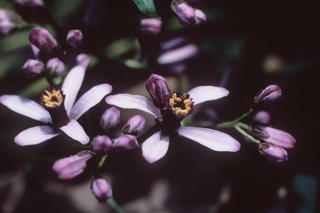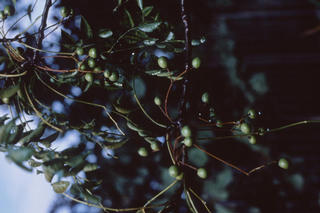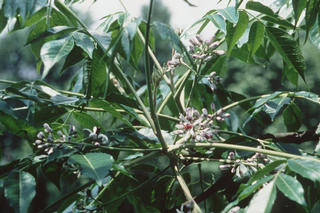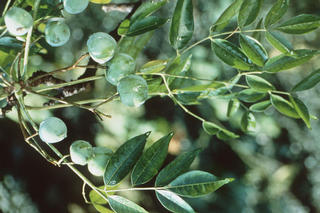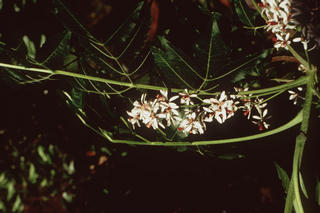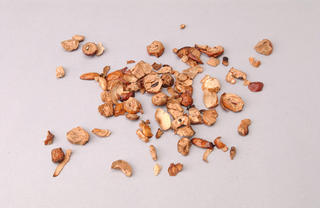Melia Toosendan
Contents
- 1 Nomenclature
- 2 Historical Use of Melia Toosendan
- 3 Background
- 4 Nomenclature
- 5 Historical Use of Melia Toosendan
- 6 Background
- 7 Nomenclature
- 8 Historical Use of Melia Toosendan
- 9 Background
- 10 Pharmaceutical Information
- 11 Evidence or the Use of Melia Toosendan in the Treatment of Epilepesy
- 12 Safety
Nomenclature
Other Names:
Historical Use of Melia Toosendan
Melia Toosendan in Traditional Chinese Medicine
Background
Kuliangenpi ¿à鬸ùƤ
Chinese Name (pinyin): Kulianpi
Chinese Name :
Common Name :Chinaberry Bark
Specific Name : Cortex meliae
Scientific Name:
Collection : The drug is ollected in spring and autumn, dried in the sun after removal of the coarse outer layer.
Description : Irregular tabular, channeled or semiquilled, varying in length and width, 2-6mm thick, outer surface greyish brown, rough with interwoven longitudinal wrinkles and dotted greyish-brown lenticels, yellowish when the outer layer is peeled, inner surface whitish or pale yellow. Texture tough, uneasily broken, fracture fibrous, laminated, easily separated. Odourless, taste bitter.
Identification : 1.Choose any section of the drug, when folded and rubbed with hands it may be laminated. The lamination appearing alternately yellow and white layers with each lamina minutely reticulated.2.Macerate about 1g of the powder with 10ml of ether for 2 hours with constant shaking and filter. Evaporate 1ml of the filtrate to dryness, add several drops of p-dimethyllaminobenzaldehyde TS dropwise, a red colour is produced. Evaporate 1ml of the filtrate to dryness in a test tube, add 1ml of acetic anhydride, stir, add several drops of sulfuric acid along the tube wall, a green colour in acetic anhydride layer , a red to purple colour in sulfuric acid layer are produced.
Processing : Eliminate foreign matter, wash clean, soften thoroughly, cut into slivers and dry.
Action : To repel worms and cure dermatosis.
Indication : ascariasis, oxyutiasis, abdominal pain due to intestinal parasitosis
external: scabies, tinea
Precautions : Used with caution in patients with hepatitis or nephritis.
Dosage : 4.5 to 9 g; for external use, appropriate quantity to be ground into powder and applied topically after mixed with lard.
Storage : Preserve in a ventilated dry place, protected from moisture.
Nomenclature
Other Names:
Historical Use of Melia Toosendan
Melia Toosendan in Traditional Chinese Medicine
Background
Jinlingzi ½ðÁå×Ó
Chinese Name (pinyin): Chuanlianzi
Chinese Name :
Common Name :Toosendan Fruit
Specific Name : Fructus Meliae Toosendan
Scientific Name:
Collection : he drug is collected in winter when ripe. Remove from foreign matter and dried.
Description : Subspherical, 2 - 3.2cm in diameter, externally golden to brownish yellow, somewhat lustrous, rarely dented or shrunken with deep brown small dots. Apex with remains of style attached, base with dent and a fruit stalk scar. Epicarp leathery, usually forming a space with sarcocarp loose and soft, pale yellow viscous when moistened with water. Kernels spherical or ovoid, texture hard, both ends truncate with 6 - 8 longitudinal ribs and 6 - 8 loculi, each loculus containing a blackish brown oblong seed. Odor characteristic, taste sour and bitter.
Identification :
Processing : Eliminate foreign matter, break to pieces before use.Stir fried : Cut and clean, thick slices or pulverize. Stir fry the drug as described under the method for simple stir frying (Appendix ll D) until the outer surface turns brown.
Action :
Indication : pain in the chest, hypochondrium and epigastrium; colic in the lower abdomen, abdominal pain due to parasitosis
Precautions :
Dosage :
Storage :
Nomenclature
Other Names:
Historical Use of Melia Toosendan
Melia Toosendan in Traditional Chinese Medicine
Background
Jinlingzi ½ðÁå×Ó
Chinese Name (pinyin): Chuanlianzi
Chinese Name :
Common Name :Toosendan Fruit
Specific Name : Fructus Toosendan
Scientific Name:
Collection : he drug is collected in winter when ripe. Remove from foreign matter and dried.
Description : Subspherical, 2 - 3.2cm in diameter, externally golden to brownish yellow, somewhat lustrous, rarely dented or shrunken with deep brown small dots. Apex with remains of style attached, base with dent and a fruit stalk scar. Epicarp leathery, usually forming a space with sarcocarp loose and soft, pale yellow viscous when moistened with water. Kernels spherical or ovoid, texture hard, both ends truncate with 6 - 8 longitudinal ribs and 6 - 8 loculi, each loculus containing a blackish brown oblong seed. Odor characteristic, taste sour and bitter.
Identification :
Processing : Eliminate foreign matter, break to pieces before use.Stir fried : Cut and clean, thick slices or pulverize. Stir fry the drug as described under the method for simple stir frying (Appendix ll D) until the outer surface turns brown.
Action :
Indication : pain in the chest, hypochondrium and epigastrium; colic in the lower abdomen, abdominal pain due to parasitosis
Precautions :
Dosage :
Storage :
Synonymns for Melia Toosendan
Patent Medicines and Medicines with Multiple Ingredients that include Melia Toosendan
Pharmaceutical Information
Chemical Constituents
Evidence or the Use of Melia Toosendan in the Treatment of Epilepesy
Basic Science
Animal Studies
Cohort, Case-Control and Non-Randomized Trials
Randomized Controlled Trials
Meta-Analysis
1st Five Results: pubmed search
Li Luo, Jinxian Lin, Sixin Chen, Jiajie Ni, Hongjie Peng, Feihai Shen, Zhiying Huang
Rosmarinic acid alleviates toosendanin-induced liver injury through restoration of autophagic flux and lysosomal function by activating JAK2/STAT3/CTSC pathway.
J Ethnopharmacol: 2024, 330;118196
[PubMed:38631488]
[WorldCat.org]
[DOI]
(I a)
Sixin Chen, Jiajie Ni, Li Luo, Jinxian Lin, Hongjie Peng, Feihai Shen, Zhiying Huang
Toosendanin induces hepatotoxicity via disrupting LXRα/Lipin1/SREBP1 mediated lipid metabolism.
Food Chem Toxicol: 2024, 187;114631
[PubMed:38570025]
[WorldCat.org]
[DOI]
(I p)
Li Luo, Jiajie Ni, Jiahui Zhang, Jinxian Lin, Sixin Chen, Feihai Shen, Zhiying Huang
Toosendanin induces hepatotoxicity by restraining autophagy and lysosomal function through inhibiting STAT3/CTSC axis.
Toxicol Lett: 2024, 394;102-113
[PubMed:38460807]
[WorldCat.org]
[DOI]
(I p)
Seong Cheol Kim, Dong Ryun Gu, Hyun Yang, Sung-Ju Lee, Jin Ah Ryuk, Hyunil Ha
##Title##
Pharmaceutics: 2023, 15(10);
[PubMed:37896213]
[WorldCat.org]
[DOI]
(P e)
Minghao Hu, Min Xu, Yuchen Chen, Zhangkai Ye, Shunpeng Zhu, Jia Cai, Mengxue Zhang, Chi Zhang, Ruizhen Huang, Qiang Ye, Hui Ao
Therapeutic potential of toosendanin: Novel applications of an old ascaris repellent as a drug candidate.
Biomed Pharmacother: 2023, 167;115541
[PubMed:37738795]
[WorldCat.org]
[DOI]
(I p)
